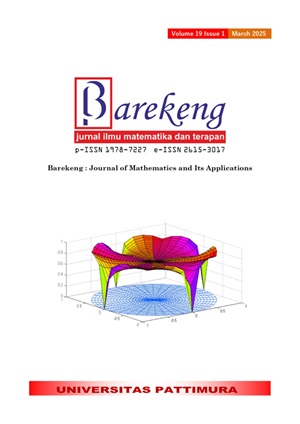FRACTIONAL-ORDER MODEL OF THE DRUG USER TRANSMISSION
Abstract
Drug abuse poses significant challenges to public health and socio-economic stability worldwide. Narcotics, which are psychotropic compounds, are typically used for treating specific medical conditions. Currently, many individuals abuse drugs outside of the function of treatment. This misuse leads to central nervous system disorders, resulting in significant mental and behavioral health issues. In this article, we discuss a fractional-order mathematical model for the transmission of drug users with fractional-order α∈ (0,1]. We employ fractional-order differential equations using the Caputo derivative approach to model the transmission dynamics. We analyze the local stability of drug-free and endemic equilibrium points and calculate the basic reproduction number (). Our analysis indicates that the drug-free equilibrium is locally asymptotically stable when , while the endemic equilibrium is stable when . We implement a numerical scheme to simulate the fractional-order model, illustrating the theoretical findings.
Downloads
References
Wang, X., Cui, J. J., Zhuo, Y., Shen, B. H., Zhang, S. J., Liu, W., Shen, M., and Xiang, P., “A retrospective of prevalence of drugs of abuse by hair analysis in Shanghai using LC-MS-MS,” Journal of Analytical Toxicology, vol. 44, no. 5, pp. 482-489, 2020.
National Narcotics Agency of Gorontalo Province, “Drugs are taking away the future of the younger generation,” 2020. [Online]. Available: https://gorontalo.bnn.go.id/narkoba-merenggut-masa-depan-generasi-muda-2/. [Accessed: 21-Apr-2024].
Ministry of Health of the Republic of Indonesia, General Overview of Drug Abuse in Indonesia, Jakarta: Ministry of Health RI, 2014.
Sasmita, F., Narcotics, Drugs and Drugs, Yogyakarta: Media Education Center, 2018.
National Narcotics Agency, Indonesia Drug Report 2023, National Narcotics Agency Research, Data and Information Center, Jakarta, 2023.
United Nations Office on Drugs and Crime (UNODC), World Drug Report 2023, United Nations Publication, Austria, 2023.
United Nations Office on Drugs and Crime (UNODC), World Drug Report 2021, United Nations Publication, Sales No. E.20.XI.6, Austria, 2021.
Liu, P., Zhang, L., and Xing, Y., “Modelling and stability of a synthetic drug transmission model with relapse and treatment,” Journal of Applied Mathematics and Computing, vol. 60, no. 1-2, pp. 465-484, 2018.
Mushanyu, J., and Nyabadza, F., “A Risk-Structured Model for Understanding the Spread of Drug Abuse,” International Journal of Applied and Computational Mathematics, vol. 4, no. 60, pp. 1-16, 2018.
Battista, N. A., Pearcy, L. B., and Strickland, W. C., “Modeling the prescription opioid epidemic,” Bulletin of Mathematical Biology, vol. 81, no. 6, pp. 2258-2289, 2019.
Ginoux, J. M., Naeck, R., Ruhomally, Y. B., Dauhoo, M. Z., and Perc, M., “Chaos in a predator-prey-based mathematical model for illicit drug consumption,” Applied Mathematics and Computation, vol. 347, pp. 502-513, 2019.
Zhang, Z., Yang, F., and Xia, W., “Hopf bifurcation analysis of a synthetic drug transmission model with time delays,” Complexity, vol. 2019, pp. 1-17, 2019.
Hafiruddin, M., Fatmawati, F., and Miswanto, M., “Mathematical model analysis of a drug transmission with criminal law and its optimal control,” in AIP Conference Proceedings, AIP Publishing, 2019.
Akanni, J. O., Olaniyi, S., and Akinpelu, F. O., “Global asymptotic dynamics of a nonlinear illicit drug use system,” Journal of Applied Mathematics and Computing, vol. 66, no. 1-2, pp. 39-60, 2021.
Akanni, J. O., “Mathematical assessment of the role of illicit drug use on terrorism spread dynamics,” Journal of Applied Mathematics and Computing, vol. 68, no. 6, pp. 3873-3900, 2022.
Barros, L. C. D., Lopes, M. M., Pedro, F. S., Esmi, E., Santos, J. P. C. D., and Sánchez, D. E., “The memory effect on fractional calculus: an application in the spread of COVID-19,” Computational and Applied Mathematics, vol. 40, no. 1, pp. 1-21, 2021.
Zafar, Z. U. A., Rezazadeh, H., Inc, M., Nisar, K. S., Sulaiman, T. A., and Yusuf, A., “Fractional order heroin epidemic dynamics,” Alexandria Engineering Journal, vol. 60, no. 6, pp. 5157-5165, 2019.
Achar, S. J., and Baishya, C., “Dynamics of modified fractional illicit drug consumption model,” Palestine Journal of Mathematics, vol. 11, no. 3, pp. 112-126, 2022.
Nwajeri, U. K., Fadugba, S. E., Ohaeri, E. O., Oshinubi, K. I., Ogunrinde, R. R., and Ogunrinde, R. B., “Co-dynamic Model of Drug Trafficking and Money Laundering Coupled with Fractional Derivative,” International Journal of Applied and Computational Mathematics, vol. 9, no. 5, pp. 1-17, 2023.
Diethelm, K., The Analysis of Fractional Differential Equations, Springer Verlag, New York, 2010.
Brauer, F., and Chavez, C. C., Mathematical Models in Population Biology and Epidemiology, 2nd ed. New York: Springer-Verlag, 2012.
Hussain, T., Ozair, M., Ali, F., ur Rehman, S., Assiri, T. A., and Mahmoud, E. E., “Sensitivity analysis and optimal control of COVID-19 dynamics based on SEIQR model,” Results in Physics, vol. 22, Article 103956, 2021.
Khalique, C. M., et al., “Dynamics of fractional-order models of drug addiction,” Mathematical Modelling and Analysis, vol. 21, no. 3, pp. 375-388, 2016.
Copyright (c) 2025 Indah Nurun Izzati, Fatmawati Fatmawati, Cicik Alfiniyah

This work is licensed under a Creative Commons Attribution-ShareAlike 4.0 International License.
Authors who publish with this Journal agree to the following terms:
- Author retain copyright and grant the journal right of first publication with the work simultaneously licensed under a creative commons attribution license that allow others to share the work within an acknowledgement of the work’s authorship and initial publication of this journal.
- Authors are able to enter into separate, additional contractual arrangement for the non-exclusive distribution of the journal’s published version of the work (e.g. acknowledgement of its initial publication in this journal).
- Authors are permitted and encouraged to post their work online (e.g. in institutional repositories or on their websites) prior to and during the submission process, as it can lead to productive exchanges, as well as earlier and greater citation of published works.






1.gif)



